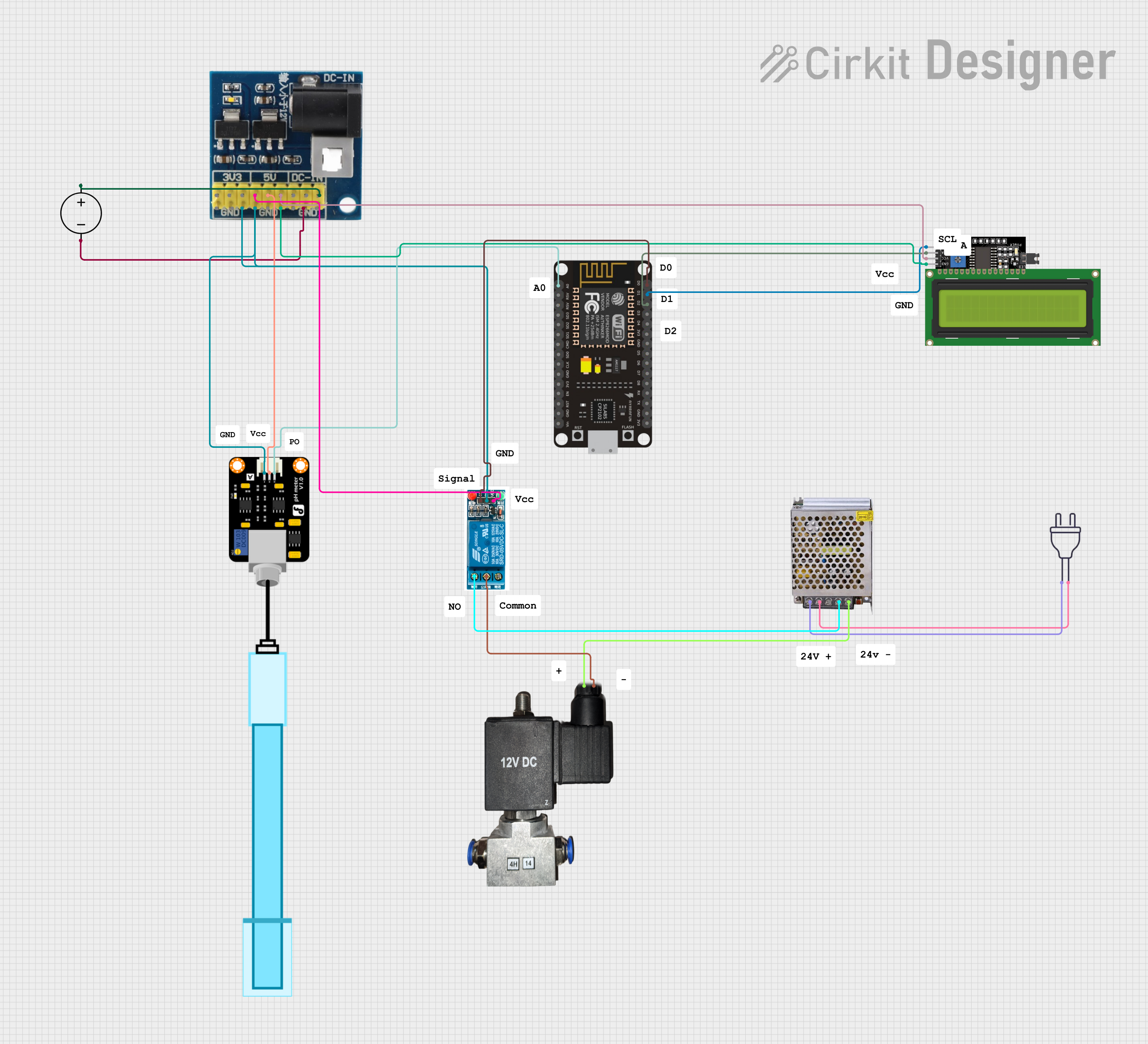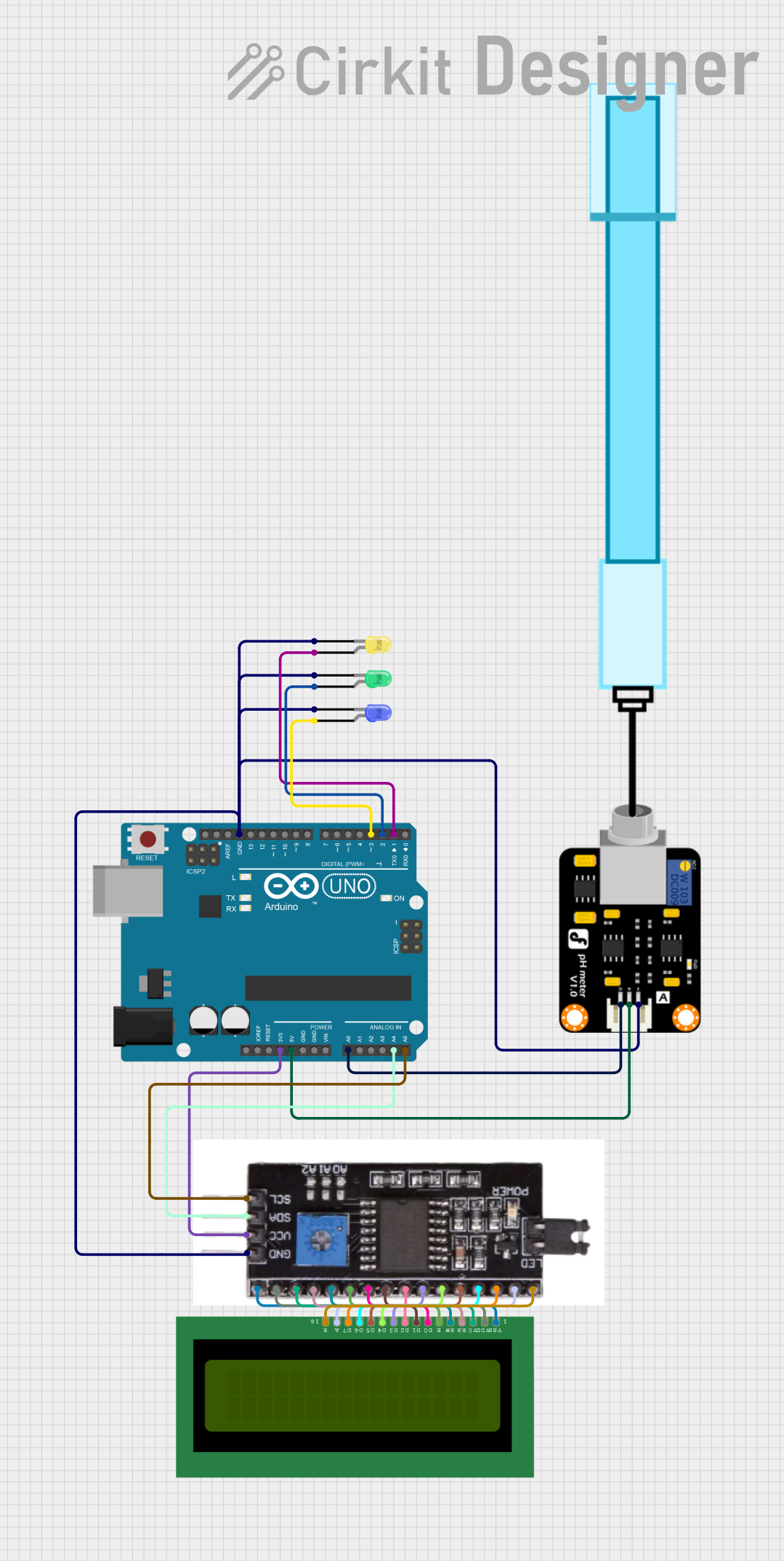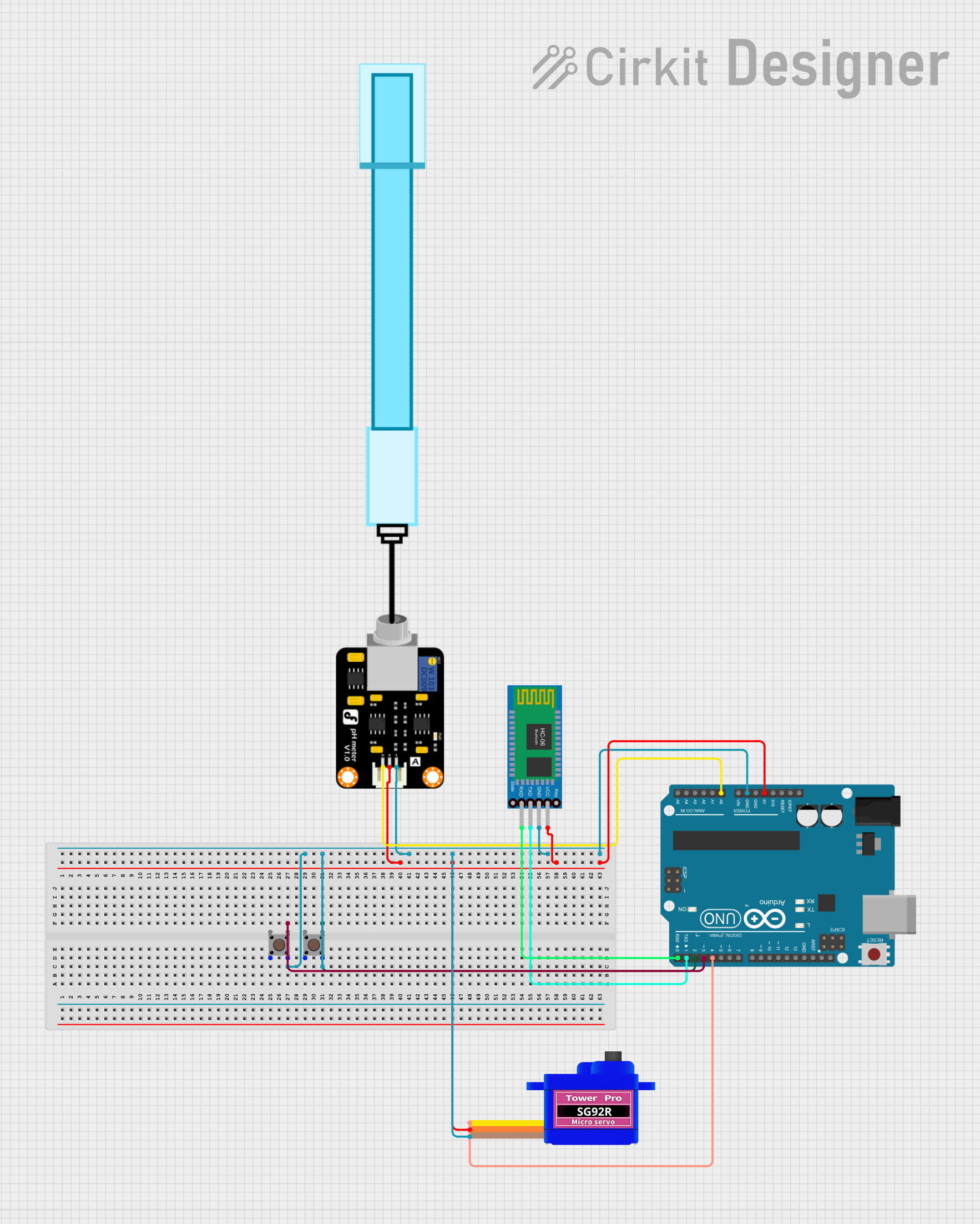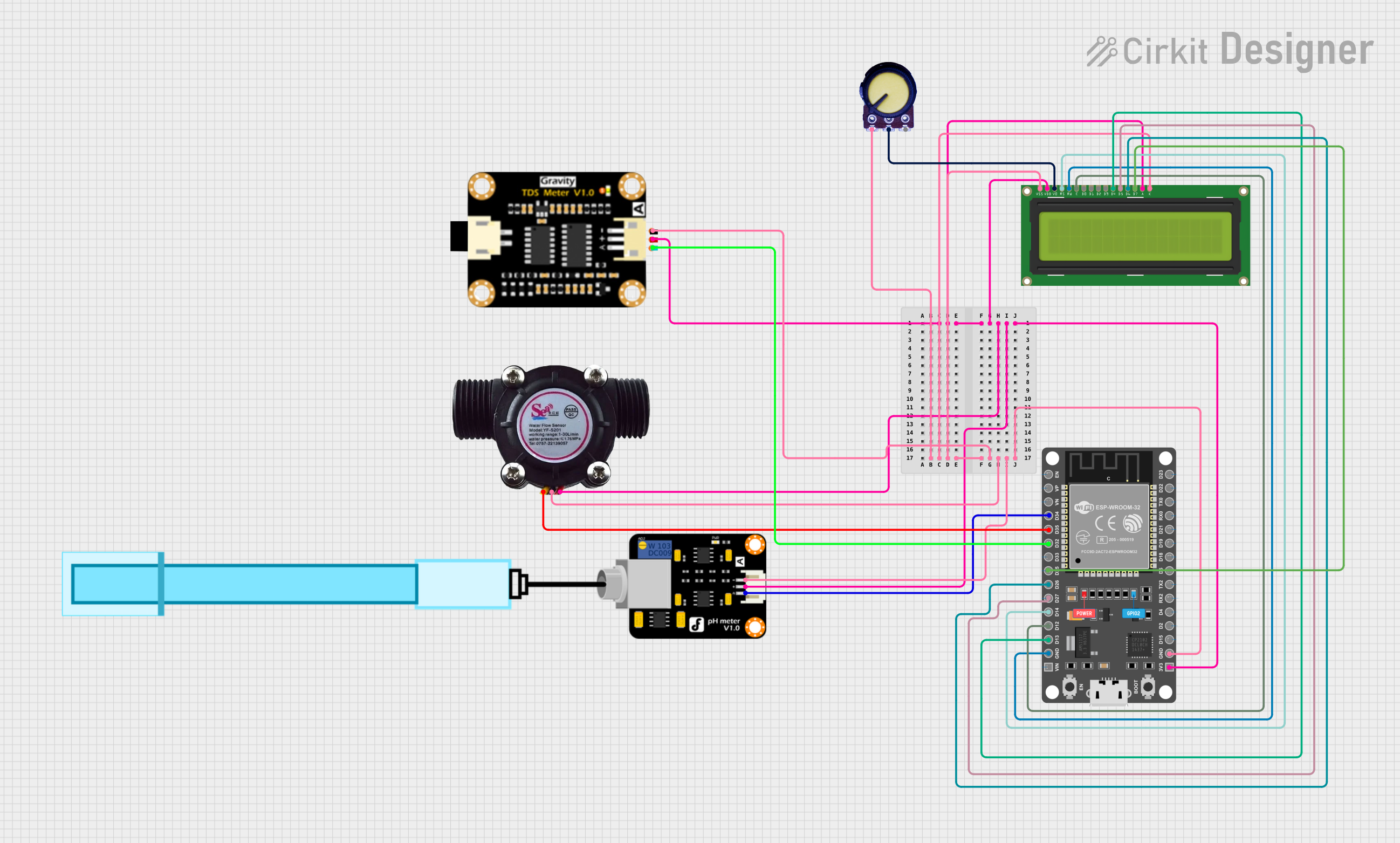
How to Use ph electrode: Examples, Pinouts, and Specs

 Design with ph electrode in Cirkit Designer
Design with ph electrode in Cirkit DesignerIntroduction
The DFRobot SEN0169 pH Electrode is a high-quality sensor designed to measure the acidity or alkalinity of a solution. It operates by detecting the concentration of hydrogen ions in the solution and generating a voltage proportional to the pH level. This sensor is widely used in applications such as water quality monitoring, aquariums, hydroponics, and laboratory experiments.
The SEN0169 pH electrode is easy to use and compatible with microcontrollers like Arduino, making it an excellent choice for both hobbyists and professionals.
Explore Projects Built with ph electrode

 Open Project in Cirkit Designer
Open Project in Cirkit Designer
 Open Project in Cirkit Designer
Open Project in Cirkit Designer
 Open Project in Cirkit Designer
Open Project in Cirkit Designer
 Open Project in Cirkit Designer
Open Project in Cirkit DesignerExplore Projects Built with ph electrode

 Open Project in Cirkit Designer
Open Project in Cirkit Designer
 Open Project in Cirkit Designer
Open Project in Cirkit Designer
 Open Project in Cirkit Designer
Open Project in Cirkit Designer
 Open Project in Cirkit Designer
Open Project in Cirkit DesignerTechnical Specifications
Below are the key technical details and pin configuration for the DFRobot SEN0169 pH Electrode:
Key Technical Details
| Parameter | Specification |
|---|---|
| Manufacturer | DFRobot |
| Part ID | SEN0169 |
| Measurement Range | 0 to 14 pH |
| Operating Temperature | 0°C to 60°C |
| Accuracy | ±0.1 pH (at 25°C) |
| Response Time | ≤1 minute |
| Output Voltage Range | 0 to 3.0V |
| Power Supply Voltage | 5V |
| Cable Length | 1 meter |
| Connector Type | BNC |
Pin Configuration
The SEN0169 pH electrode is typically used with a pH sensor interface board. Below is the pin configuration for the interface board:
| Pin Name | Description |
|---|---|
| VCC | Power supply (5V) |
| GND | Ground |
| AOUT | Analog output (pH signal) |
Usage Instructions
How to Use the pH Electrode in a Circuit
- Connect the Electrode to the Interface Board: Attach the pH electrode to the BNC connector on the interface board.
- Connect the Interface Board to a Microcontroller:
- Connect the
VCCpin of the interface board to the 5V pin of the microcontroller. - Connect the
GNDpin of the interface board to the GND pin of the microcontroller. - Connect the
AOUTpin of the interface board to an analog input pin (e.g., A0) on the microcontroller.
- Connect the
- Calibrate the Electrode:
- Use standard buffer solutions (e.g., pH 4.0, pH 7.0, and pH 10.0) to calibrate the sensor for accurate readings.
- Adjust the potentiometer on the interface board to fine-tune the output.
Important Considerations and Best Practices
- Storage: Always store the electrode in a pH electrode storage solution to prevent it from drying out.
- Cleaning: Rinse the electrode with distilled water after each use to avoid contamination.
- Calibration: Regularly calibrate the electrode to maintain accuracy, especially before critical measurements.
- Avoid Damage: Do not expose the electrode to extreme temperatures or corrosive chemicals beyond its specified range.
Example Code for Arduino UNO
Below is an example Arduino sketch to read pH values using the SEN0169 pH electrode:
// Include necessary libraries
// No additional libraries are required for basic analog reading
// Define the analog pin connected to the pH sensor
const int pH_pin = A0;
// Define variables for pH calculation
float voltage, pH_value;
void setup() {
// Initialize serial communication for debugging
Serial.begin(9600);
}
void loop() {
// Read the analog value from the pH sensor
int sensorValue = analogRead(pH_pin);
// Convert the analog value to voltage (assuming 5V system)
voltage = sensorValue * (5.0 / 1023.0);
// Convert the voltage to pH value
// The formula may vary based on calibration; adjust as needed
pH_value = 3.5 * voltage;
// Print the pH value to the Serial Monitor
Serial.print("pH Value: ");
Serial.println(pH_value);
// Wait for a short period before the next reading
delay(1000);
}
Note: The formula for converting voltage to pH value may vary depending on calibration. Adjust the multiplier (
3.5in the example) based on your calibration results.
Troubleshooting and FAQs
Common Issues and Solutions
Inaccurate Readings:
- Cause: The electrode is not calibrated.
- Solution: Calibrate the electrode using standard buffer solutions.
No Output or Constant Value:
- Cause: Loose or incorrect connections.
- Solution: Check all connections between the electrode, interface board, and microcontroller.
Slow Response Time:
- Cause: The electrode is dirty or damaged.
- Solution: Clean the electrode with distilled water or a cleaning solution. Replace if damaged.
Dry Electrode:
- Cause: The electrode was not stored in a storage solution.
- Solution: Soak the electrode in a storage solution for at least 24 hours before use.
FAQs
Q1: Can the SEN0169 pH electrode be used with liquids other than water?
A1: Yes, but ensure the liquid is within the electrode's operating temperature and pH range. Avoid highly corrosive or viscous liquids.
Q2: How often should I calibrate the electrode?
A2: Calibration frequency depends on usage. For critical applications, calibrate before each use. For general use, calibrate weekly.
Q3: What is the lifespan of the SEN0169 pH electrode?
A3: The typical lifespan is 1-2 years, depending on usage and maintenance.
Q4: Can I use the electrode without the interface board?
A4: No, the interface board is required to condition the signal for microcontroller compatibility.
By following this documentation, you can effectively use the DFRobot SEN0169 pH Electrode for accurate and reliable pH measurements.